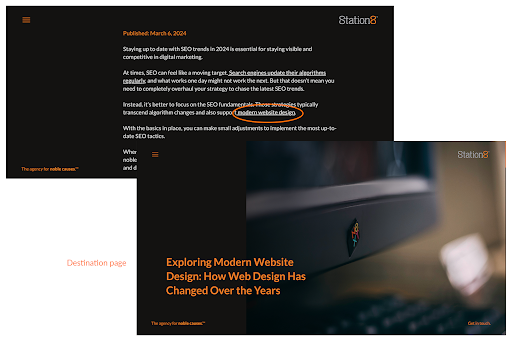How user experience affects SEO
So you’ve started your search for a talented web design firm to create and launch an engaging, beautiful new website. Thrilling, but are you considering how user experience affects SEO?
Are you taking into consideration ux and seo at all? If not, you should be.
When it comes to SEO, many web designers overlook the importance of a good UX strategy. But it is an important factor at the heart of a good SEO strategy and digital marketing.
Why? To start, a healthy website structure allows Google to easily discover, index and return your website in search results.
But it runs deeper. Let’s consider some user metrics.
Make the user journey easy with good UX
A good website structure and user experience (ux) naturally lead visitors to the information they need. It coaxes them to connect dots and facilitates the overall website objectives.
If your website engages and allows users to easily piece together information, they’ll click on more pages. This results in a higher click through rate (CTR) – a valuable search engine ranking metric for Google.
If visitors can’t find what they’re looking for due to poor UX, they won’t click through your website. And they’ll leave – or bounce.
Bounces measured over time reflect your bounce rate, which is another user metric Google relies on to determine search engine rankings.
Good UX impacts SEO by decreasing bounce rate and increases user time on your site. Google likes to see both of these things because it says, “Hey! This site has a great user experience!”
Search and user experience go hand in hand. If your goal is high search engine rankings, prioritizing a sturdy website structure will help you better target low bounce rates and increased time on page.
UX and links
How else does UX affect SEO? Google awards clearly organized websites with sitelinks — important links that also appear in results.

These additional pages support navigation and signal to users that they’re in the right place.
Sitelinks help visitors get to where they need to go faster. For example, let’s say a pilot wants a new pair of his or her favorite sunglasses:
When you build a website with clarity and accuracy, Google provides you with sitelinks like these. It’s a great way to direct traffic to relevant landing pages on your site.
Another way SEO and UX design go hand in hand relates to internal linking. Internal links are individual pages linked together within your website.

Importantly, a good internal linking strategy decreases the number of clicks it takes a visitor to access information.
Conclusion
Humans are creatures of logic, and an intuitive UX design in your website allows users to easily find the information they’re looking for.
If your website is a cluttered mishmash of pages with no clear structure, it’s creating an SEO roadblock. If the information fails to guide visitors, they’ll move on.
To be sure, superior UX, engaging content and an effective backlink campaign must supplement your website structure. Nevertheless, proper structuring is the springboard for good SEO.
Understanding how user experience affects SEO is paramount for any website owner or developer. By prioritizing user experience, you can significantly improve your search engine rankings and drive more organic traffic to your site.
Published: August 28, 2019